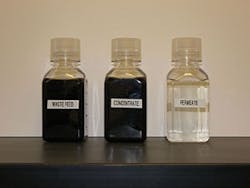The city of St. Cloud, located 27 miles south of Orlando, Fla., supplies water to a rapidly growing community of approximately 45,000 people. The water supply is sourced from the underlying aquifer and contains fairly high levels of dissolved organic carbon (DOC) and dissolved sulfide. To ensure compliance with current and future U.S. Environmental Protection Agency (EPA) water quality standards and improve the sustainability of its operations, the city has not only installed the largest operating MIEX system in North America, but is also the first to implement the EcoRegen technology, a process that allows the recycling of up to 70% of the residuals produced by the MIEX process.
The MIEX process, developed by Orica Watercare Inc., utilizes a magnetized anion exchange resin in a mixed or fluidized bed ion exchange reactor to remove DOC, sulfide and other anionic compounds. Treatment residuals from the MIEX process consist of a brine solution resulting from regeneration of the ion exchange resin. The city discharges this waste directly to sewer. As the city’s wastewater plant practices 100% reuse of treated effluent, the MIEX system was installed with the flexibility to regenerate with standard sodium chloride or sodium bicarbonate if treated wastewater chloride levels restricted reuse applications. Sodium chloride is the preferred regenerant, however, due to the higher cost of sodium bicarbonate.
Since startup in March 2008, the MIEX system has consistently reduced raw water TOC levels by more than 70% and subsequent trihalomethane and haloacetic acid levels by more than 60% and 70%, respectively, well under the EPA standards (Figure 1). Dissolved sulfide levels have also been reduced to below detection. While treatment residual levels are very low, at less than 0.1% of plant throughput, the city continued to investigate methods to reduce salt discharges to sewer in order to maximize the ability to reuse treated wastewater as it expands the MIEX technology to its other treatment facilities.
Figure 1
A Sustainable Future
One of the options investigated was upgrading the resin regeneration system to the recently developed EcoRegen process. This process incorporates advanced membrane filtration to filter dissolved organics and sulfate from the waste brine and allows reuse of the permeate for resin regeneration. A trial of this process conducted by Orica Watercare in the summer of 2009 demonstrated that more than 97% of the organics and 90% of the sulfate could be removed while allowing a 75% recovery of the waste brine. When integrated into the existing regeneration system, waste volumes discharged to sewer will be reduced by more than 80% and the recycling of salt will reduce salt discharges by more than 70%. A full-scale system is under construction and scheduled to begin operating in June 2010.
“The city did not hesitate to implement a new technology when it provided the most economical and effective water treatment strategy,” said Todd Swingle, public services administrator with the city of St. Cloud. “We are also continually striving to improve the sustainability of our operations, and the EcoRegen upgrade helps us to meet this goal by significantly reducing our salt costs while minimizing the MIEX system’s impact on the environment.”
*Swingle, T, et al. “St. Cloud, FL and MIEX – Clearly a Success,” Proceedings of AWWA Annual Conference, June 2009.


